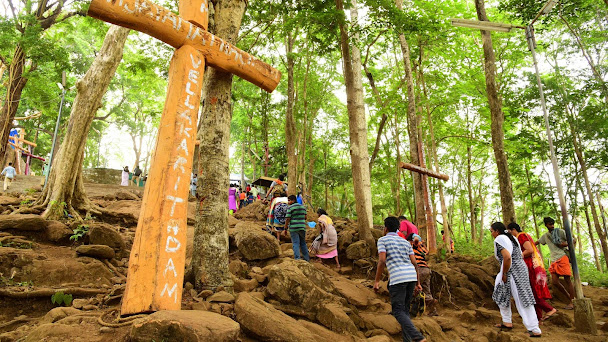Valliyoorkavu Temple: Goddess of the Tribes
The hills of Wayanad have many stories which are more of legends & beliefs among the people. The land is a place which has been the home of tribals & its their way of life that has made the place so habitable. There are many temples around this beautiful land which have some unique stories. One such temple is the Valliyoorkavu Devi temple which attracts a large population for its annual festival.
The temple is in Mananthavady & stands in a large field with a simple structure similar to traditional Kerala houses. Though the structure is simple, the complex has the Sreekovil, Nadapanthal, Pathayapura. The temple also has two different Kavu within called the Mele kaavu & Kezhu kaavu. The architecture at one glance is a simple design & it is attributed to the thought that the temple was built by the tribals who believed in Bhakti & not the opulence of architecture.
The idol of the Goddess is a self manifested image & the temple worships the deity in three forms as Vana Durga, Bhadrakali & Jala Durga depending on who is the worshipper. For the tribals the Goddess is Vana Durga as she is the protector of their way of life, for most the deity is Bhadrakali, the ferocious being & for the adivasis she is the Jala Durga who protects their livelihood along the river Kabini. The origin of the temple is said to be in the 14th century & the King of Kottayam was the one who built the temple. It is said that an oracle was travelling along Wayanad & rested along the Kabini river. The oracle is said to have been a big devotee of the Goddess & was a great healer. As he rested along the banks, his sword & anklet disappeared & when he woke up was shocked to find it missing. The panicked oracle looked for his beloved items all around & asked the Paniya Tribal leader for help to find it. The tribal leader did not know how it looked or what it meant but he asked his people to search for the items. His people looked around the river & forests for days, but could not find it on the ground. It was only after many days that a tribal man found the sword & anklet hanging from the creeper (valli) of a peepal tree. As the men climbed the tree, the items fell to the ground with a voice telling all that the Goddess had decided to rest here in the form of Vana Durga, Bhadrakali & Jala Durga. The king of Kottayam was appraised by this divine event & immediately came to the place, prayed & ordered his people to build a temple. From that day all the major tribes of Wayanad like the Paniya, Adiyars, Kurumas, Kaadans consider the Goddess their ooru devi (deity of the tribe).
The temple rituals are quite simple & people from all sects are allowed to pray here. At the Keezhu kavu one can see the swayambhoo image of the Goddess inside a sanctum while at the mele kaave is the image of Vana Durga with no roof as she is protector of the forests. The annual 14 day festival at the temple is considered to be one of the important events in Wayanad & people from all over come to see the unique rituals performed here. All the devotees during the festival can be witness to the kalamezhuthu tradition which is painting of the Goddess on the floor in her most ferocious or subtle form with rice powder. It is also the place where one can see the Oppana Varavu which is a procession bringing tender coconuts for abhishekam from the Cheramkode Bhagavathy temple for the arattu of Valiyooramma. It is also important to note that the oppana Varavu is also conducted to conclude the festival when the procession returns to Cheramkode temple after the rudhira kolam which is an artform symbolising the death of the demon Darika at the hands of the Bhagawathi. Another unique aspect of the festival is that the ceremonial flag hoisting initiating the festival in most temples is only done on the 7th day of the festival by the tribal chieftains of different tribes here. The valliyooramma sword which was found by the tribes is brought to the temple on the first day of the festival marking the start of the 14 day festival. The festival ends with the tribal dance where even the oracles perform.
The temple in earlier centuries had been a place only visited by the tribals but its reverence was so much that even people from far off come to pray here now. Though many are legends or folklore, most of the tribes around have different stories of the origin of the temple but what is important to know is that the temple has been true to its existence as a protector of the people around.




I appreciate you sharing the information you have provided. It is quite useful and is informative because Tribal Dance forms of Kerala contains some of the most useful information.
ReplyDelete